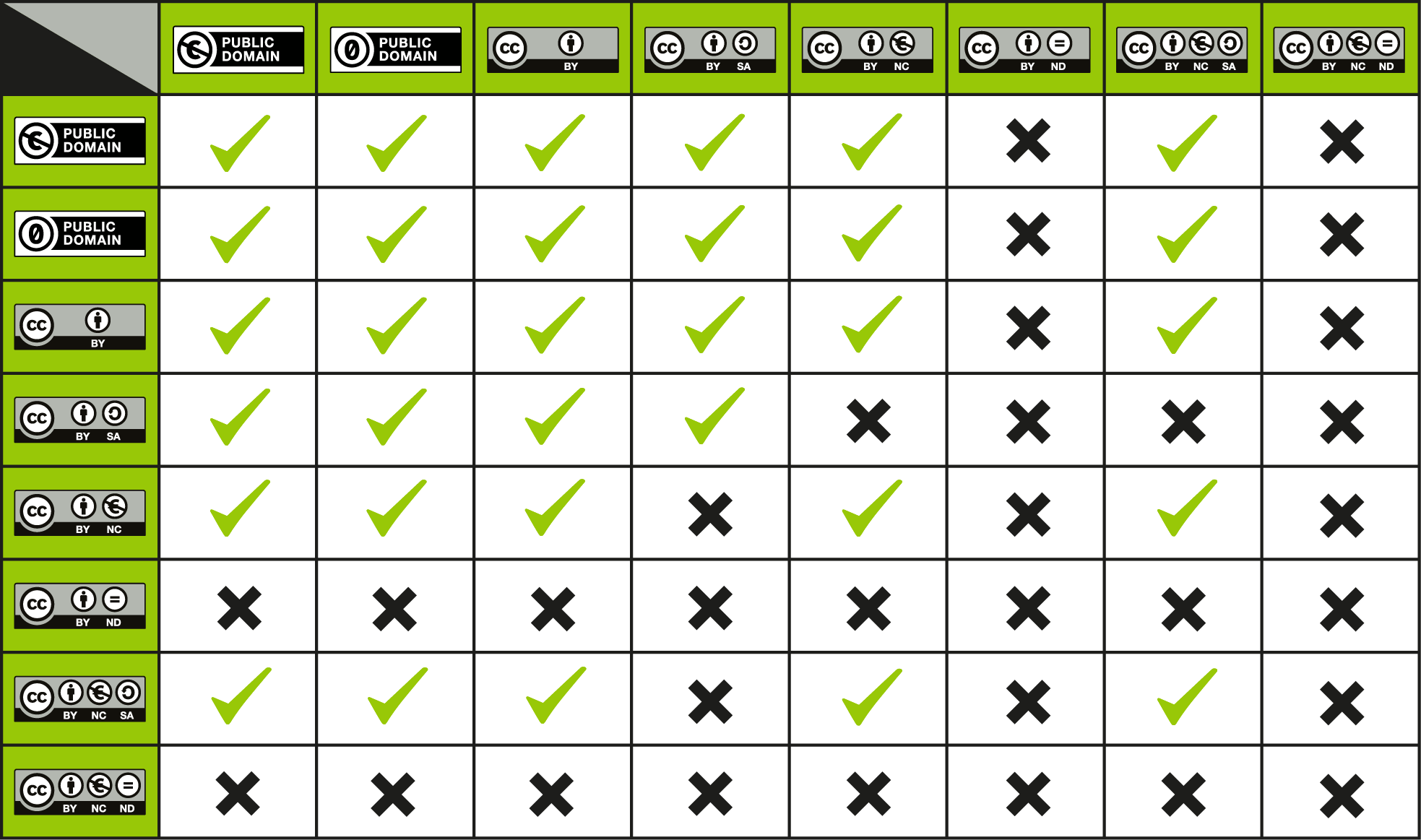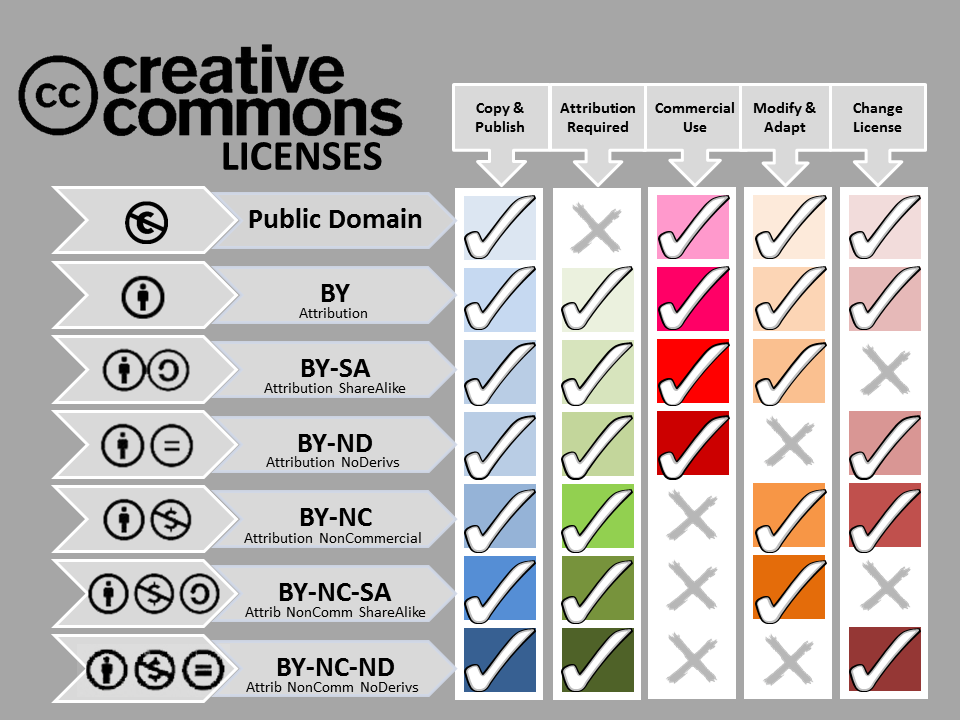Creative Commons Licenses
What are Creative Commons and Open Licences?
An important element of open educational resources, specifically open textbooks in the University of Regina OER catalogue, is that they are openly licensed, but what does that mean?
Open licences enable collaboration, development, access, and inspiration from your creative works without requiring you to give up the rights (copyright) automatically granted to you for your creation.
An open licence lets you retain ownership of your work, while allowing others to use, share, and remix it, without requesting your permission. For most open licences, all that is required of the users is to attribute you for your work.
What is copyright?
Whenever you produce a new creative work – whether that’s a new song or story, a picture or a painting, a slideshow or study guide – you are automatically granted a copyright where all your rights are reserved. You don’t need to do anything to be granted a copyright, and it’s intended to protect your work from being used in ways you don’t want, without your express permission.
Wanna Work Together? by Creative Commons CC BY
To freely share your creative work, including open textbooks, without requests for permission, you can dedicate your work to the public domain, or license it openly. The Archer Library has a page with information for faculty and students at https://www.uregina.ca/copyright/. For help on copyright, visit the copyright contact information page at https://www.uregina.ca/copyright/contact/index.html.
Public domain
Items in the public domain are not protected by intellectual property laws, including copyright, trademark, or patent laws. Public domain belongs to the public – no individual can claim any right to the material, and it can be used by anyone without obtaining permission.
Here are four of the typical ways that works end up in the public domain:
- The copyright has expired
- The existing copyright owner failed to renew the copyright
- The work was dedicated to the public domain
- Copyright law is not applicable to this type of work (example: short phrases, facts and theories, and U.S. government works)
*Copyright law varies from country to country, and a work can be in the public domain in one country, but not necessarily in another.
Open Licensing
You can choose an open licence to maintain your copyright while enabling the public to use and remix your creative work. An open licence grants permissions and states restrictions; the specific permissions granted depend on the type of open licence you choose. For the open textbooks in the University of Regina OER Collection, we use licences from Creative Commons to create access to these materials across the province and around the world.
Creative Commons (CC) Licences
Creative Commons (CC) licenses are the global standard for open licensing of OER. CC licenses have been adopted globally by governments, publis sector bodies, academic publishers and cultural heritage institutions including museums and libraries. Using these licences, you as an author, can give your permission to share and reuse your creative work, with the conditions you choose.
Every individual CC licence communicates to potential users the terms under which they can use the resource. There are four CC licence elements:
| BY | The 'BY' or Attribution licence element requires that users of the resource attribute the licensor (copyright holder) of the resource; all CC licences (excluding CC0) include the attribution element. |
| SA | The 'SA' or Share-Alike licence element requires that all derivative works that include this resource be shared using the same licence |
| NC | The 'NC' or Non-Commercial licence element requires that the resource is "not primarily intended for or directed towards commercial advantage or monetary compensation", i.e., commercial usage rights are withheld |
| ND | The 'ND' or No Derivatives licence element allows the resource to be shared, but prohibits adaptation, translation or modification of the resource in any way; ND-licensed resources do not meet the full definition of OER because of this limitation on revision and remix. |
These four different licence elements are combined in various ways to create the six main Creative Commons licences. Note that CC licences are written in the format 'CC' followed by a space and then the relevant licence elements combined with hyphens. In addition to the six main CC licences is a CC0 Public Domain licence.
At the University of Regina OER Program, most of our resources are licensed under a Creative Commons Attribution 4.0 International Licence, which means you are free to share and adapt the content, as long as you give appropriate credit, provide a link to the licence, and indicate if changes were made.
The copyright licences offered through Creative Commons grant specific permissions depending on the licence you choose for your work. The licences include:
 CC BY
CC BY
Attribution (BY) – This licence allows others to distribute, change, remix, and build upon your work, even commercially, as long as they credit you for the original creation. This licence gives anyone using your work the most permissions.
 CC BY-SA
CC BY-SA
Attribution (BY) ShareAlike (SA) – This licence allows others to distribute, change, remix, and build upon your work, even commercially, as long as they credit you for the original creation. This licence is often compared to open source software licences. You, and anyone using your new version of this work, must release these adaptations with the same (“share alike”) CC BY-SA licence.
 CC BY-NC
CC BY-NC
Attribution (BY) NonCommercial (NC) – This licence allows others to distribute, change, remix, and build upon your work as long as they credit you for the original creation. However, they cannot sell it or profit from it except to recuperate the costs of printing, for example. It is a nonprofit licence.
 CC BY-NC-SA
CC BY-NC-SA
Attribution (BY) NonCommercial (NC) ShareAlike (SA) – This licence allows others to distribute, change, remix, and build upon your work as long as they credit you for the original creation. However, you cannot sell it or profit from it except to recuperate the costs of printing, for example. It is a nonprofit licence. You, and anyone using your new version of this work, must release these adaptations with the same (“share alike”) CC BY-NC-SA licence.
 CC BY-ND
CC BY-ND
Attribution (BY) NoDerivatives (ND) – This licence allows for redistribution, commercial and non-commercial, as long as it is passed along unchanged and in whole, with credit to you. These are accepted on a case-by-case basis.
 CC BY-NC-ND
CC BY-NC-ND
Attribution (BY) NonCommercial (NC) NoDerivatives (ND) – This licence is the most restrictive of the six main Creative Commons licences, allowing redistribution. This licence is often called the “free advertising” licence because it allows others to download and share your work with others as long as they credit you, but they must be passed along unchanged and in whole or use them commercially. It is a nonprofit licence.
The 5 R's of OER and CC Licensing
OERs are resources that are freely available for anyone to use, adapt, distribute, translate and share with no or very minimal restrictions. They are not only about cost savings but are developed by individuals who share the belief that the world's kknowledge is a public good and should be accessible to all. The 5 R's of OER are:
- Retain: you can make and own copies of the resource
- Reuse: you can use the resource in your own context
- Revise: you can adapt, modify, translated and improve the resource
- Remix: you can combine and recombine the resource with other material
- Redistribute: you can share the resource with others
Anyone using Creative Commons licenses needs to be aware of how these licenses allow for reuse. The image below shows this for each license.
When selecting OER under a Creative Commons license, the user must also be aware of how the resource created from the existing source can be licensed. The following image shows the different variations possible. The license of the original OER is shown on the left. Possible licensing options of the derivatives are shown in the top row.

You can download a Creative Common licence quick reference sheet for your personal use assets/OERCreativeCommonsLicensesQuickRef.pdf
A useful summary of the content on this page is the following video by David Wiley on High Impact Practices for integrating Open Educational Resources (OER) into University Courses.
High Impact Practices for integrating OER by Creative Commons CC BY
For some additional information on copyright related to the Canadian higher educational sector, the University of Alberta library has a series of modules available at the link https://sites.library.ualberta.ca/copyright/modules/access-copyright-v-york/.
Zero-Cost Material Courses
The University of Regina started tracking courses that exclusively use teaching materials and resources freely available and easily accessible to students. Zero-cost teaching materials and resources may include open-access books and other open-access educational resources available through various on-line platforms as well as digital books, journal articles, and other types of educational resources that are easily and freely available to students through the University Library's online services. A link to these University of Regina courses is listed on the Registrar's page at Zero-cost Material courses.


